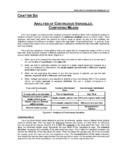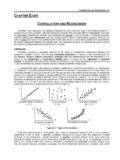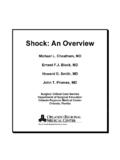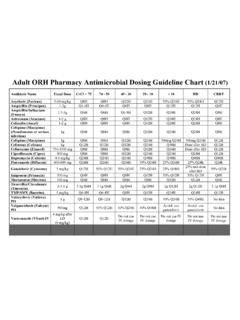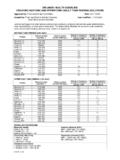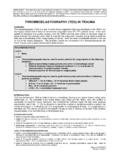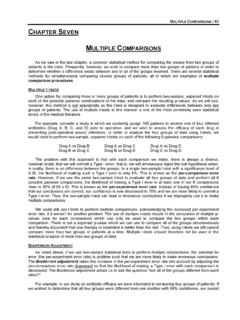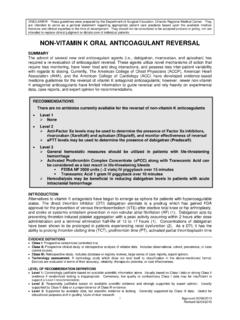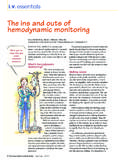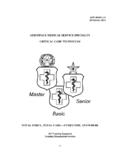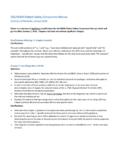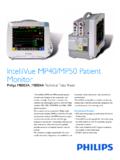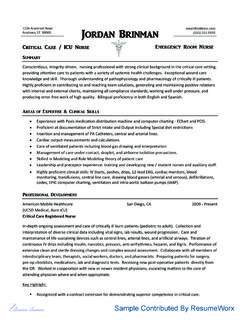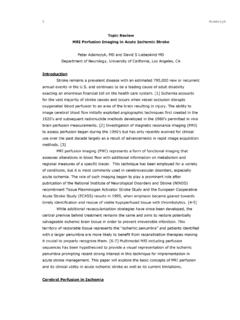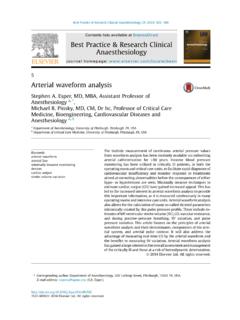Transcription of hemodynamic calculations I - SurgicalCriticalCare.net
1 hemodynamic calculations I - M. L. Cheatham, MD, FACS, FCCM_____Revised 01/13/20091_____HEMODYNAMIC hemodynamic MONITORING IMONITORING IMichael L. Cheatham, MD, FACS, FCCMM ichael L. Cheatham, MD, FACS, FCCMD irector, Surgical Intensive Care UnitsDirector, Surgical Intensive Care UnitsOrlando Regional Medical CenterOrlando Regional Medical CenterWHAT IS hemodynamic MONITORING? We assess all patients using the five vital signs We assess all patients using the five vital signs Temperature, blood pressure, heart rate, Temperature, blood pressure, heart rate, respiratory rate, arterial oxygen saturationrespiratory rate, arterial oxygen saturation Critically ill patients demonstrate pathophysiologic Critically ill patients demonstrate pathophysiologic changes in organ function that require closechanges in organ function that require closechanges in organ function that require close changes in organ function that require close observation and scrutinyobservation and scrutiny CardiacCardiac PulmonaryPulmonary RenalRenal HepaticHepatic CerebralCerebralWHAT IS hemodynamic MONITORING?
2 A variety of advanced monitoring techniques exist A variety of advanced monitoring techniques exist that allow assessment of such endthat allow assessment of such end--organ functionorgan function Pulmonary artery catheterizationPulmonary artery catheterization Arterial waveform pulse contour analysisArterial waveform pulse contour analysis Esophageal DopplerEsophageal Dopplerpgpppgpp EchocardiographyEchocardiography BioimpedanceBioimpedance Carbon dioxide excretionCarbon dioxide excretion Each of these are discussed in a separate lectureEach of these are discussed in a separate lecture First, we need to cover some general principlesFirst, we need to cover some general principlesWHY DO WE MONITOR PATIENTS? MonitorMonitor to keep watch over to keep watch over to keep track of by an electronic device to keep track of by an electronic device to scrutinize or check systematically with a view to scrutinize or check systematically with a view to scrutinize or check systematically with a view to scrutinize or check systematically with a view to collecting certain specified categories of data to collecting certain specified categories of data The American Heritage DictionaryThe American Heritage DictionaryIN THEORY.
3 WE MONITOR PATIENTS Generate Generate physiologic dataphysiologic data Guide therapeuticGuide therapeuticinterventionsinterventions Avoid progressionAvoid progressionof organ dysfunction to multiple of organ dysfunction to multiple organ failureorgan failureorgan failureorgan failure Allow Allow earlyearly detectiondetectionof problems of problems Identify the need for Identify the need for changes in treatmentchanges in treatmentstrategystrategyBUT DO WE REALLYMONITOR PATIENTS? A 31 question multipleA 31 question multiple--choice examination of choice examination of invasive hemodynamic monitoring knowledge was invasive hemodynamic monitoring knowledge was administered to attending and resident physiciansadministered to attending and resident physicians 77% residents / fellows77% residents / fellows 23% attending physicians23% attending physicians Mean score: 67% (range 19 Mean score: 67% (range 19--100%)100%) 47% of physicians could not derive basic 47% of physicians could not derive basic information from a pulmonary artery catheter information from a pulmonary artery catheter (PAC)(PAC)Iberti et al.
4 1990 Iberti et al. 1990 hemodynamic calculations I - M. L. Cheatham, MD, FACS, FCCM_____Revised 01/13/20092_____ The same examination was subsequently given to The same examination was subsequently given to 216 critical care nurses at a nursing convention216 critical care nurses at a nursing convention Mean score: 49%Mean score: 49% 42% of nurses could not identify a pulmonary 42% of nurses could not identify a pulmonary tli(PAOP) d tli(PAOP) d BUT DO WE REALLYMONITOR PATIENTS?artery occlusion pressure (PAOP) or wedge artery occlusion pressure (PAOP) or wedge tracing correctlytracing correctlyIberti et al. 1994 Iberti et al. 1994 HOW ABOUT CRITICAL CARE PHYSICIANS? Another similar multiple choice examination was Another similar multiple choice examination was administered to critical care specialists to assess administered to critical care specialists to assess their understanding of hemodynamic monitoringtheir understanding of hemodynamic monitoring The mean score was higher (83%, range 10 The mean score was higher (83%, range 10--100%)100%)
5 HOWEVERHOWEVER HOWEVERHOWEVER 33% could not identify a PAOP tracing33% could not identify a PAOP tracing 33% could not determine how to increase a 33% could not determine how to increase a patient s oxygen deliverypatient s oxygen delivery 54% admitted they use the data from a patient s 54% admitted they use the data from a patient s PAC 5 or fewer times per dayPAC 5 or fewer times per daySociety of Critical Care Medicine, 1996 Society of Critical Care Medicine, 1996DO WE REALLYMONITOR PATIENTS? Significant deficits exist regarding fundamental Significant deficits exist regarding fundamental concepts of hemodynamic monitoring and concepts of hemodynamic monitoring and pulmonary artery catheterizationpulmonary artery Pulmonary artery catheters are Pulmonary artery catheters are diagnostic toolsdiagnostic toolsyyyyggand not therapeutic interventionsand not therapeutic The outcome of a patient with a pulmonary The outcome of a patient with a pulmonary artery catheter is altered artery catheter is altered onlyonlyif management is if management is guided by the data obtainedguided by the data These same conclusions apply to any These same conclusions apply to any monitoring technologymonitoring technologySociety of Critical Care Medicine.
6 1996 Society of Critical Care Medicine, 1996 WHEN WE DECIDE TO monitoring CANNOT have a hemodynamic monitoring CANNOT have a positive impact on patient outcome without:positive impact on patient outcome without:1)1)Knowledgeable interpretationKnowledgeable interpretationof the dataof the dataandand2) Institution of 2) Institution of appropriate therapy appropriate therapy based on based on the data obtainedthe data obtainedTHE IDEAL MONITOR WOULD AccurateAccurate ReliableReliable SimpleSimple ContinuousContinuous SafeSafe InformativeInformative UsefulUseful CostCost--effectiveeffectiveA IDEAL MONITOR IS AccurateAccurate ReliableReliable SimpleSimple Subject to variabilitySubject to variability Prone to artifactProne to artifact ComplexComplexXR ContinuousContinuous SafeSafe InformativeInformative UsefulUseful CostCost--effectiveeffective Intermittent dataIntermittent data Significant risksSignificant risks Can be erroneousCan be erroneous May change therapyMay change therapy ExpensiveExpensiveHemodynamic calculations I - M.
7 L. Cheatham, MD, FACS, FCCM_____Revised 01/13/20093_____HOW DO WE MONITOR PATIENTS? NoninvasiveNoninvasive Sphygmomanometric cuff blood pressureSphygmomanometric cuff blood pressure ElectrocardiographyElectrocardiography Urinary outputUrinary output InvasiveInvasive Arterial pressure monitoringArterial pressure monitoring Central venous pressure monitoringCentral venous pressure monitoring Pulmonary artery catheterizationPulmonary artery catheterization Intracranial pressure monitoringIntracranial pressure monitoring IntraIntra--abdominal pressure monitoringabdominal pressure monitoringWHEN SHOULD WE MONITOR PATIENTS? One should consider invasive hemodynamic One should consider invasive hemodynamic monitoring when patients: monitoring when patients.
8 Fail to respond to resuscitation as documented byFail to respond to resuscitation as documented by Ongoing or worsening shockOngoing or worsening shock Progressive or refractory lactic acidosisProgressive or refractory lactic acidosis Progressive or refractory lactic acidosis Progressive or refractory lactic acidosis Develop organ dysfunction / failureDevelop organ dysfunction / failure Have preHave pre--existing cardiopulmonary dysfunctionexisting cardiopulmonary dysfunction May benefit from preoperative assessment based May benefit from preoperative assessment based upon an increased risk for upon an increased risk for perioperativeperioperative morbidity morbidity and mortalityand mortalityEVOLUTION OF RESUSCITATION GOALSD ecadeDecadeDefinition of ShockDefinition of ShockResuscitation GoalsResuscitation Goals1970 s1970 sInadequate Inadequate cardiac outputcardiac outputblood pressure, heart blood pressure, heart rate, urinary output, rate, urinary output, central venous pressurecentral venous pressure1980 s1980 sInadequate oxygenInadequate oxygentransport balancetransport balancemixed venous oxygen mixed venous oxygen saturation (SvOsaturation (SvO22), )
9 , pulmonary artery pulmonary artery occlusion pressureocclusion pressure1990 s1990 s--2000 s2000 sInadequate end Inadequate end organ perfusion & organ perfusion & oxygenationoxygenationlactate, lactate, pHipHi, RVEDVI, , RVEDVI, oxygen delivery, oxygen oxygen delivery, oxygen consumptionconsumptionPRIMARY MONITORING QUESTIONS There are four questions that should be asked of There are four questions that should be asked of any critically ill patientany critically ill patient Is intravascular volume or preload adequate?Is intravascular volume or preload adequate? Is blood flow adequate?Is blood flow adequate? Is vascular resistance appropriate?Is vascular resistance appropriate? Is oxygen transport balance adequate? Is oxygen transport balance adequate? MEASURED VS.
10 CALCULATED VARIABLES The hemodynamic parameters used in clinical The hemodynamic parameters used in clinical practice are eitherpractice are either MeasuredMeasured Directly determined from a monitoring deviceDirectly determined from a monitoring device CalculatedCalculated Mathematically determined from measured Mathematically determined from measured variablesvariables More subject to measurement errorMore subject to measurement error Operator errorOperator error Dynamic response artifactsDynamic response artifacts Measuring device errorsMeasuring device errorsMEASURED PRESSURE VARIABLESV ariableVariableAbbreviationAbbreviationS ystolic blood pressure Systolic blood pressure SBPSBPD iastolic blood pressure Diastolic blood pressure DBP DBP Systolic pulmonary artery pressure Systolic pulmonary artery pressure PAS PAS Diastolic pulmonary artery pressure Diastolic pulmonary artery pressure PADPADP ulmonary artery occlusion pressure Pulmonary artery occlusion pressure PAOPPAOPC entral venous pressure Central venous pressure CVPCVPI ntraIntra--abdominal pressure abdominal pressure IAPIAPI ntracranial pressure Intracranial pressure ICP ICP hemodynamic calculations I - M.


